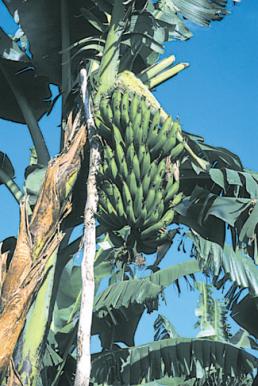Banana Ontology 
 |
Curator Marie-Angélique Laporte, Alliance Bioversity-CIAT Naama Menda, Boyce Thompson institute Contributor Amos Asiimwe, CIRAD |
Expert Group
|
Institutions
|
|---|
Navigation
 =Term,
=Term,  =Trait,
=Trait,  =Method, and
=Method, and  =Scale
=Scale
Variables
Concept details
| Key | Value |
|---|---|
| scale_id | CO_325:0100095 |
| scale_name | Meredith and Lawrence (1969) - complete |
| ontology_id | CO_325 |
| ontology_name | Banana |
| scale_class | Nominal |
| category_1 | 1 = Initial speck stage: symptoms are first visible to the naked eye as faint, minute (less than 0.25 mm diam), reddish brown specks on the lower surface of the leaf. Specks are often most abundant near the margin of the left side of the leaf, particularly towards the tip. Where leaf spot is severe, specks have been observed on the second leaf of plants that have not yet produced a bunch. Elsewhere they usually appear on the third, fourth, or older leaves. |
| category_2 | 2 = First streak stage: the initial speck elongates, becoming slightly wider, to form a characteristic narrow, reddish brown streak up to 20 mm long and 2.0 mm wide, with the long axis parallel to the leaf venation. At this stage, streaks are more clearly visible on the lower surface of the leaf than on the upper one. The distribution of streaks is variable. Sometimes they are most numerous near the edge of the left side of the leaf. At other times they are equally numerous on both sides of the leaf, and more or less evenly distributed. Frequently they are densely aggregated in a band several cm wide on one side or both sides of the mid-rib, becoming less numerous towards the edge of the leaf. Streaks may be so numerous that every cm2 of leaf surface bears one or more. There is considerable variation in the length of individual streaks on a given leaf, and they frequently overlap to form larger, compound streaks. |
| category_3 | 3 = Second-streak stage: the streaks may elongate slightly, but the most notable change is that in colour from reddish brown to dark brown or almost black, sometimes with a purplish tinge. The streak is now clearly visible on the upper surface of the leaf. The distribution of streaks at this stage of development varies in the same way as mentioned above. When streaks are very numerous, and more or less evenly distributed, the entire leaf blackens. |
| category_4 | 4 = First-spot stage: the streak broadens and becomes more or less fusiform and elliptical in outline and similar to the first-spot stage of Sigatoka (Leach 1946). The transition from streak to spot is further characterised by the development of a light brown, water-soaked border around the spot. This water-soaked effect is especially clear in the early morning, when dew is still present on the leaf, or after rain. |
| category_5 | 5 = Second-spot stage: the dark brown or black central area of the spot becomes slightly depressed and the water-soaked border becomes more pronounced due to darkening. At this stage, a slight yellowing of the leaf tissue immediately surrounding the water-soaked border may occur. |
| category_6 | 6 = Third or mature spot stage: the centre of the spot dries out, becoming light grey or buff-coloured, and further depressed. The spot is surrounded by a narrow, well-defined, dark brown or black border. between the latter and the normal green colour of the leaf, there is often a bright yellow transitional zone. After the leaf has collapsed and withered, spots remain clearly visible because of the light-coloured centre and dark border. |
| language | EN |
| created_at | 2023-09-04-13:19:28 |